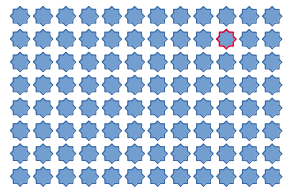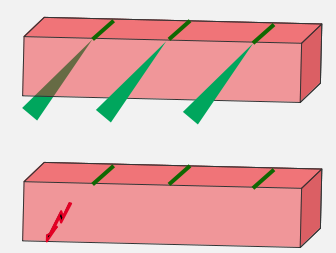CATEGORIES
Human Error
Not a matter of expensive equipment
When laser diode production volume is low, the only equipment necessary is a microscope with sufficient magnification and proper glare-free illumination. A camera connected to the microscope is a meaningful addition that helps to document images of interesting features for later reference and study. For edge emitters, a fixture able to flip the laser bar on four sides is also helpful to inspect the two mirror facets, p- and n-side. The importance of facets for edge-emitters cannot be overstated, but let’s just state here, that the facets bare the highest optical density and pose one of the most vulnerable parts of the edge emitting laser diode. For the most part, they absolutely need to be flawless and optical inspection of the facets is mandatory.

For an edge-emitter laser diode (left side), not only the top side (usually the p-electrode) but also the facets that make the cavity should be inspected. A vertical emitter (right side of the picture) is sufficiently inspected only from the top side.
Top Notch Capabilities of the Human Brain
Manual optical inspection can be time-consuming but needs very little capital investment and the human eye is very skilled to identify damages, particles, cracks, holes, discolorations, and so on.
Although being able to classify all the different details pertaining optical defects of specific device types can take some learning effort: Being able to identify deviations of almost any kind between a perfect picture and a defective picture is a human inborn capability.
In almost any competition about image recognition and analisys, the human brain always wins over a computerized approach. Throughout the human evolution, the capability to distinguish details that for example could mean eating a poisonous weed or discarding it, has made the optical capabilities one of the key human assets.
Artificial intelligence algorithms are learning to mimic the human capability of identifying defects, shapes and ultimately giving meaning to shapes in random pictures but they still take longer, require computing power and their error rate is higher.

Likely nobody will need a ton of training to identify the different fruit in this basket. It is hard to accept but unfortunately true, that if this variation appeared at random after watching 1000 flawless pictures or more, many people would miss the red star.
Being Easily Bored
When scaling to high production level volumes, the amount of human error rises significantly. Also, a group of skilled operators is required, which in many cases will render different results if the decision parameters are ambiguous. This can easily happen when small defects are passed but larger defects rejected. Ambiguous defects tend to be passed by one engineer while rejected by another, especially under time pressure.
If the tedious, boring job of microscopy is performed several hours, the amount of human error produced is significant and not only translates in erroneously sorted out good diodes (false negatives) but unfortunately also on some erroneously approved bad diodes (false positives).

An edge emitting laser diode with three separate active areas is shown with laser emission on the top of the picture. The sample in the bottom shows a crack in the emission facet. The quality department has elaborated that if this crack expands, it could affect the active area. This laser diode should not be delivered. But due to its ambiguity different persons looking at the picture could take the quick decision that the crack expansion direction does not affect the vulnerable active area and that the sample can be delivered..
Do you like what you see?
We value your feedback, so let us know what you think!
Let us also know which topics you would like to see expanded.
Just give us a call, send us an e-mail or use the form to contact us.
